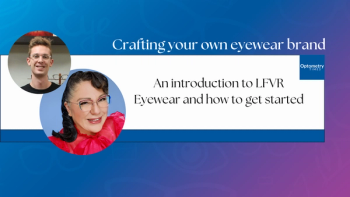
New lens analysis approach could improve treatments for myopia
Instrumentation recreates properties of the myopic eye to test lenses that prevent visual decline.
Researchers have developed new instruments for rigorously quantifying and comparing the light focusing properties of specialized eyeglass lenses that are used to slow the progression of
According to a news release, myopia is on the rise around the globe, especially among children. According to a 2016 study published in the American Academy of Ophthalmology Journal, if the rates of myopia continue to increase at current levels, more than half of the world’s population will be myopic by 2050.
Myopia also can lead to serious issues such as glaucoma, retinal detachment, and even permanent blindness down the road, and the risks rise the younger a child’s myopia starts.
Although the drivers of this trend aren’t entirely clear, specialized eyeglass lenses have been shown to keep myopia from getting worse. This is particularly important for children and teens who often experience progression in the condition as their bodies grow.
In the study, published in Optica,1 researchers from the ZEISS Vision Science Lab at the University of Tübingen, in Germany, and the University of Murcia, in Spain, describe their new instruments, which measure lens performance under real-world viewing conditions. They also report results from measuring the light focusing characteristics of different lenses used to slow myopia progression.
“Insights into the link between the optical properties of myopia progression management lenses and effectiveness in real-world scenarios will pave the way to more effective treatments,” study author Augusto Arias-Gallego, from the Zeiss Vision Science Lab said in the news release. “This could help millions of children and is fundamental in understanding the mechanisms by which these lenses work.”
Capturing real-life viewing conditions
Myopia is typically caused when a person’s eyes become slightly elongated. This leads faraway objects to appear blurry because they are focused in front of, rather than onto, the
Lenses that modify retinal signals to reduce myopia progression have been clinically tested and are currently available in the market. Researchers hypothesize that these lenses slow the growth of the eyeball, preventing it from becoming more elongated. These lenses incorporate different types of structures, such as microlenses or microdiffusers, to manipulate the image properties at the peripheral retina while correcting the central vision. However, the optical properties of this relatively new technology have not been extensively studied and compared.
In the work, the researchers wanted to thoroughly characterize the currently available lenses under real-world viewing conditions.
“After exploring the state of the art, we didn’t find a method that could be used to characterize the optical properties of these eyeglass lenses under real viewing conditions,” Arias-Gallego explained. “Therefore, we developed a new instrument that can measure the lens’s optical response to different angles of illumination while reproducing the myopic eye’s pupil and refractive errors.”
The new instrument uses an illumination source that is mounted on an arm that rotates around the lens. After the light passes through the lens, a steering rotating mirror guides it toward a spatial light modulator (SLM), which is composed of tiny liquid crystal cells that modify the propagating light with high spatial resolution.
The SLM is the core of the instrument since it reproduces the refractive errors and pupil shape of myopic eyes. This allowed the researchers to reproduce, for the first time, real aberrations produced by different angles of illumination for different myopic eyes while testing the lenses. Those aberrations were programmed as phase maps using the SLM.
Moreover, programmed amounts of defocus can be induced with the SLM, enabling the researchers to conduct a through-focus test. This test captures the image quality within the proximity of a simulated retinal position, shedding light on how the lens interacts with eye elongation signaled at the retina.
According to the news release, the researchers also quantified the lenses’ light scattering properties, which was important because one of the tested lenses is based on contrast reduction by adding scattering. For this, they designed a custom setup that does not require the specialized detectors and moving parts conventionally required for scattering quantification.
Comparing lens properties
“By combining the through-focus results with light-scattering measurements, we were able to accurately characterize several types of eyeglass lenses,” said Arias. “We then compared our measurements for each lens with their reported clinical efficacy for slowing myopia progression. The results raised new questions that need to be studied further while also pointing to potential strategies that could increase the efficacy of future designs.”
In this work, the lenses were characterized using a single wavelength of light to simplify the analysis of the image properties. Because the illumination in real scenarios contains many wavelengths, the researchers are working to adapt the instrument to include sources with varying wavelengths.
Two primary environmental factors appear to have a casual association with childhood myopia. First is education. Despite the challenges of quantifying results with subjective methods such as questionnaires, a meta-analysis indicates a relationship. For each additional dioptre-hour of near work per week, the odds of becoming myopic increase by 2%.
While outcomes of studies of near work and myopia have not been consistent, there is substantial evidence to indicate a broader relationship between myopia and education. In countries where children are exposed to education at an early age, and for more hours per week, in countries with established national education systems and among students who attend selective schools and achieve high academic grades, myopia prevalence increases.
The second environmental factor is time spent outdoors. A systematic review of the relationship has concluded that as outdoor time increases, myopia onset reduces. Children who experience lower light exposure tend to exhibit axial length growth. However, outdoor time is not as effective in slowing or stopping myopia's progression.
Among prevention methods, increased outdoor time is considered the most accessible, non-invasive option. Clinical trials in China and Taiwan resulted in decreased incidences of myopia among schoolchildren involved in the study, across age groups from six to 14. In addition, while a rebound affect can occur after ceasing treatment, both test groups in one study showed significant difference from the control group with as few as 26 minutes of outdoor exposure per day.
These environmental factors interact with genetic influences on myopia's onset and progression. Because heritability estimates of identified genes indicate only a portion of myopia is hereditary, it is vital that environmental factors are considered, especially in prevention efforts. Risk factors such as rural/urban differences, gender, and socioeconomic status should also be quantified in conjunction with one another.
Other therapeutic strategies, such as low-concentration atropine and optical interventions, can also be successful in some use cases. These therapies have resulted in reduced myopic shift and reduced myopia progression.
Identifying pre-myopia, early and accurately, allows preventataive measures to be put into place. An accessible prevention strategy like increased outdoor time can have a significant impact on at-risk children, delaying the age of onset and reducing myopia prevalence in the youth population.
Reference:
1. A. Arias, A. Ohlendorf, P. Artal, S, Wahl, “In-depth optical characterisation of spectacle lenses for myopia progression management,” Optica. 10, 5 (2023). DOI: 10.1364/OPTICA.486389.
Newsletter
Want more insights like this? Subscribe to Optometry Times and get clinical pearls and practice tips delivered straight to your inbox.


















































.png)


